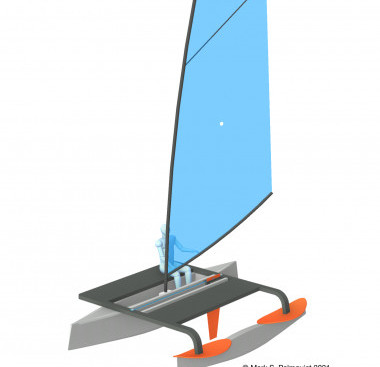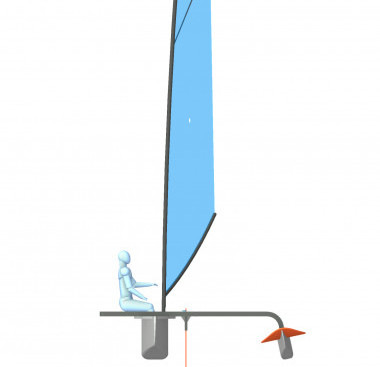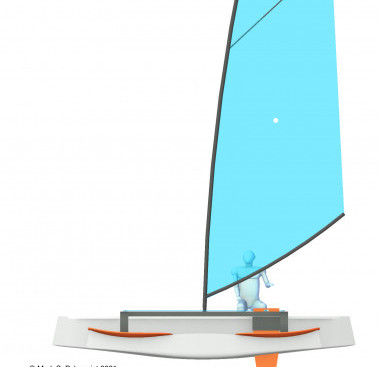A Planing Proa Concept
Mark Palmquist is a craftsman and furniture designer from Frederick, Maryland, who has sent us some 3d models of his intriguing new proa design. He writes:
Background:
Mark Palmquist is the son of Martti J. Palmquist, a pilot and inventor who experimented with and patented a new type of multihull called a ‘Wingmaran’ which is similar to a trimaran but instead of long skinny amas, it features a high aspect ratio hydroplaning wing. Martti tragically died in a plane crash before securing funding for a 12 meter long version. Mark was studying mechanical engineering at Georgia Tech at the time. Mark has uploaded a proof of concept video his father made in 1987.
The State of the Art:
When Mark reached the age of 50 he started investigating the current state of the art in multihull technology to see if his father’s idea still had any merit. He discovered that sailboats have indeed sprouted wings but that the wings are hydrofoil (underwater) instead of hydroplane (on the surface). He investigated whether a windsurfer was faster or slower with an underwater hydrofoil attached. To his surprise, he found out that hydroplaning still has an advantage over hydrofoiling in terms of speed potential because of its smaller wetted surface area and less overall drag. He also noticed that while foiling is smoother, it is also prone to sudden loss of control and cavitation.
For the last 3 years Mark has delved into sailboat design, reading every book he could find. He discovered proas and has been studying and analyzing the differences between the Pacific version (with ama to windward) promoted by thousands of years of Polynesian development (and also Russell Brown and others) and the Atlantic version (ama to leeward) which was developed by Dick Newick. He also looked into the Harry Proa approach of shifting the weight to windward but keeping the sail on the leeward hull.
While there are advantages and disadvantages of all three proa configurations, Mark believes there is more speed potential in an Atlantic proa that incorporates hydroplaning lift forward and to leeward of the sail CE.
The Boat:
PP1 (Planing Proa 1) is one of his designs. Like CHEERS, designed by Dick Newick, the sail and ballast are on the windward float, the sail pivots around a fixed mast step and both hulls are equal in length. Instead of dual dagger boards which can be moved up or down to balance the helm, Mark is experimenting with a single leeboard that can be moved forward or aft in a track to balance the helm and resist leeway. The leeward float has 2 large hydroplaning surfaces which engage the surface of the water when the wind picks up and do not allow the leeward float to submerge. If you make the hydroplaning surface wide enough and with a positive angle of attack it will resist diving even when the winds pick up and increase the heeling force. This allows the main hull to skim or fly which reduces wetted surface area and increases speed. Also, the dual hydroplaning surfaces resist bow wave creation as the waves are flattened soon after they are created.
Mark is also experimenting with a sail that is part windsurfing sail and part crab claw, a flat topped crab claw with curved spars.
Mark has made several scale models and is planning on making a full sized boat to test his theories.







Certainly worth a try. The fastest sailingboat so far, Vastas Sailrocket is a (rather specialised) hydroplaning proa.
Circuit racing hydroplanes and float planes prove the point. There was a big French multihull that tried a hydroplaning design but for whatever reason it didn’t work out. (That does NOT by any means prove anything!)
However, I feel waves will be the challenge. Hydrofoils can work under the surface and find a smooth track. Hydroplanes have to work with the surface of the water, whatever turmoil it may be in.
I particularly like the Yakaboo style steering using a sliding board.
Look forward to hearing how it goes!